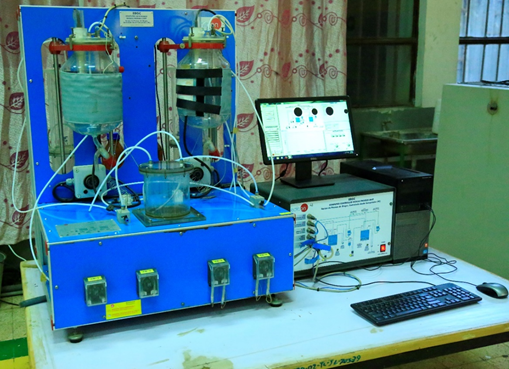Read our latest newsletter. Our latest newsletter is now available with updates, photos and stories of what is going on the EUZW Project
- Author
-
Kassa Wudineh Liyew
- Title
- Status Update On Biomass Conversion Remote Lab At Bahir Dar University
- News
-
Bahir Dar University has secured the Biomass Conversion Remote Lab after long procurement procedure. The most important component of the lab, biogas composition analyzer is bought and integrated to the EBGC unit. A huge appreciation goes to the top management at the procurement department for facilitating effectively.
This unit is designed to study and understand the different processes involved during the biogas generation through anaerobic breakdown, as well as the study of the different parameters that affect the anaerobic digestion itself and the value of the obtained biogas.
The EBGC unit supplies two packed anaerobic digesters of 5 liters. In this way, the user can work either in only one stage or in two stages, separating the two different phases of the digestion process (the processes of hydrolysis, acidogenesis, and acetogenesis would take place in the first digester, and the methanogenesis in the second digester).
Both digesters have a heating blanket that allows for regulating both the appropriate temperature for each part of the process and the operation with different ranges depending on the used microorganisms. Thus, it can operate at the psychrophilic range (room temperature), mesophilic range (temperatures around 35 oC) or thermophilic range (temperatures around 55 o C).
The unit has four peristaltic pumps which enable the propelling of both the supply to be introduced in the digester and the acid and the base (introduced in two Pyrex vessels of 1 L. each located at the rear side) in order to thoroughly adjust and control the pH in each stage of the process. In case of working in an anaerobic digestion in two stages, one of the pumps carries the product from one of the digesters to the other, passing through a buffer tank of 1 L, which collects the excess flow from the first reactor. The control of these pumps allows us to know the different flows with which the unit is working.
Two volumetric tanks are also included for the storage and volume measurement of the generated biogas. The generated biogas flows through a pipe from the upper side of the digesters to these tanks, where the biogas volume is measured by means of a water displacement. Such tanks have two parts: the upper side is where the generated biogas is collected, and the second part, smaller than the first one and located below it, is used to collect the displaced water.
Each digester has a temperature sensor and a PH meter. Their function is to follow the whole process and study the influence of the different controlling parameters in the anaerobic digestion.
Finally, the volumetric tanks, on their upper side, enable the flow of the collected biogas through a pipe and its passing through a methane (CH4) sensor (biogas analyser). The biogas analyser allows us to know the methane concentration. This way, the biogas quality, depending on the physical-chemical conditions under which the anaerobic digestion is developed, can be determined, as well as its value as a renewable energy source.

....END....
